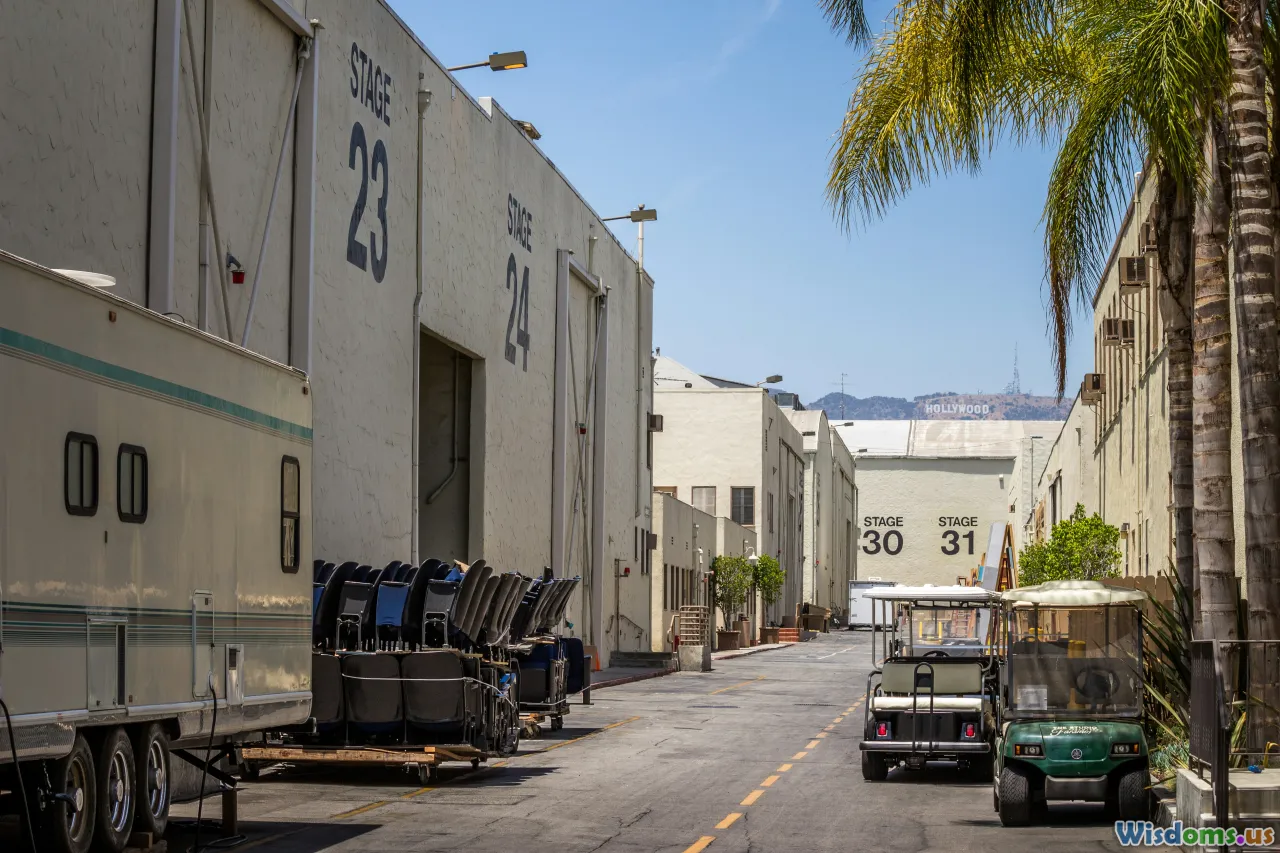
Ten Logistics Tricks That Speed Up Any Film Production
12 min read Discover ten advanced logistics strategies proven to accelerate any film production's timeline, enhance efficiency, and prevent costly delays with real-world examples and expert insights. (0 Reviews)
Ten Logistics Tricks That Speed Up Any Film Production
Film production is exhilarating—and notoriously chaotic. Sheets of call times flutter in the wind, gear gets misplaced, and weather forecasts become gospel. From indie shorts to blockbuster studio tentpoles, time truly is money. But what differentiates seamless productions from sinking ships? The answer, more often than not, is logistics.
Efficient logistics make the magic invisible: every shot prepped in advance, every department in sync, every contingency ready. Whether you're a producer, first assistant director, or even a department head eager to enhance your shoot's effectiveness, mastering production logistics isn't just helpful—it's essential.
In this in-depth guide, we'll unlock ten advanced logistics tricks utilized by professionals on successful sets worldwide. These insights, backed by real-world examples and practical details, promise to reclaim time, maximize your resources, and keep your set running smoother than ever.
1. Digitize and Sync All Schedules in Real-Time
Reliance on outdated printouts and endlessly revised Excel sheets is a recipe for confusion. Instead, productions are embracing digital scheduling tools like Scenechronize, StudioBinder, and Yamdu.
Example: On the Marvel Studios lot, production coordinators champion cloud-based production books. Scene chronize linked schedule updates in real-time across devices, keeping location managers, ADs, and department heads instantly aligned to every minute change.
Real Value: According to a 2021 research study by PureMix, production sets using a cloud-based call sheet saw a 17% reduction in daily overruns—a direct result of instantly communicated timing and address changes.
Key Takeaway: Push all principal crew to access a shared master schedule online (with read/write permissions set by role). Integrate shoot plans, meal breaks, and transport pick-ups for a single source of truth.
2. Cluster Shooting Days by Location, Not Script Order
Ambitions to shoot chronologically dissolve with each location move. The fastest schedules consolidate scenes by location—even if your script jumps across timelines.
Real Insights: Tarantino’s "Pulp Fiction" shot Vincent’s story, Mia’s overdose, and the restaurant holdup non-sequentially at the same locations. With clever scheduling, they saved four additional shoot days.
Pro Producers’ Trick: During pre-production, cross-reference shooting scripts and location availabilities. Build an optimized matrix of scenes vs. geographic availability—sometimes a single, tough decision upfront saves entire shooting days.
3. Advance Location Scouts with Drone Tech
Traditional location scouts require time-consuming walkthroughs with the core team. Modern logistics teams supplement this with drone footage and 360º VR mapping before and after initial walkthroughs, giving every department rich specifics about spatial logistics, lighting, and access.
In Practice: "The Mandalorian" team embraced drone scouts to visualize desert set accessibility within minutes rather than driving the entire crew out for each visit. This allowed set designer Andrew Jones to fix access points and parking logistics days ahead, avoiding the notorious "unit base chaos."
Benefit: Fewer in-person scouts, more certainty regarding routes, set-ups, and crew parking. VR mapping attaches to production cloud folders for immediate, detailed virtual walk-throughs for set dressing and safety planning.
4. Embrace Pre-Rigging and Strike Crews
Logistics isn’t just about plans—it’s also managing set activity in real time. Smart productions employ ‘pre-rig’ crews tasked with prepping, lighting, or even partially dressing the next set while shooting continues elsewhere.
Example: On "Stranger Things" Season 4, electricians and set dressers pre-lit upcoming sets overnight, ensuring a near-instant transition as soon as the main unit wrapped a location. Result: daily set-up times dropped by 35% across an 11-week schedule (source: Netflix production notes).
How to Apply:
- Assign a small team per department (grip, electric, art) for the pre-rig duty.
- Schedule them ahead with detailed punch lists—based on input from locations and directors.
- Strike teams follow the shooting crew for immediate post-wrap breakdowns, getting locations cleared for the next use.
5. Implement Daily Briefings and Debriefings
It may sound elementary, but dedicated, time-boxed production meetings at the start and end of each shooting day are a proven time-saver. These huddles ensure every crewmember understands priorities, urgent changes, and concerns before (and after) every shoot day.
Professional Wisdom: “The five minutes you save by skipping a morning round-up cost you thirty troubleshooting problems later on,” says Emmy-winning 1AD Michelle Sitterson.
Execution:
- Use mornings for priorities and known changes (e.g., script, weather, or transport alerts).
- Use wrap sessions for debriefs, capturing problems/solutions and prepping the next call sheet.
6. Optimize Gear and Prop Flows with RFID Tracking
On big and small shows alike, equipment goes missing or turns up late, stalling entire departments.
Solution: Embrace RFID (Radio Frequency Identification) tracking on gear and props. Most modern rental houses now offer RFID-tagged equipment—tied into production inventory software. You’ll know who had what, when, and where.
Case Study: A 2022 AICP survey showed RFID tracking saved $12,000–$21,000 in lost/delayed equipment costs per mid-sized commercial shoot.
Practical Steps:
- Insist rental partners supply tagged gear.
- Integrate datasets with production management software.
- Assign each department a gear wrangler to oversee inflow/outflow logs at each location base.
7. Map Actor and Extra Flows—And Use Color Coding
Managing cast and extras across locations and holding areas is a logistical art. Film sets that implement clear, visible color-coded signage (vests, badges, wristbands) reduce confusion and delays by streamlining traffic in bustling holding or staging spaces.
Real-World Example: When filming "Crazy Rich Asians" in multiple crowded Singapore locations, producers instituted a colorblind-friendly wristband system for background, principals, and crew for instant access control—which sped up wrangling by an estimated 25 minutes per shift.
Tips for Adoption:
- Assign colors by role (cast/crew), by day, or even by permission level (e.g., red = silent area on rolling; yellow = staging; green = mobile).
- Post simple signage with key routes mapped, especially for scenes with high extra counts (think dance floors, battle sequences).
8. Use Specialized Logistic Apps for Transport and Catering
Relying on group texts or ad hoc emails for van pickups or lunch orders is a recipe for disaster.
Solution: Dedicated transport and catering apps (such as CrewFood or Croogloo) enable cast and crew to confirm pickups, log dietary restrictions, and minimize communication delays.
Numbers Matter: According to Storyful Tech, such app adoption on film sets cut average lunch delays by 18% and drastically improved dietary compliance—and no more “missing vans” drama!
Best Practices:
- Coordinate with shuttle teams and drivers via a live-tracked schedule (Waze, Crew Commute).
- Pre-load crew headcounts and allergy lists with catering partners, updating in real time if call times shift.
9. Establish a Dedicated Contingency Team
Invariably, last-minute crises—sick talent, weather changes, traffic snags—emerge. Assigning a proactive troubleshooting unit (2–3 floats, dedicated to transport, health and safety, emergency gear) has become a go-to on fast-paced sets.
Industry Case: On “Mission: Impossible—Fallout,” a rotating troubleshooting team (known as the Delta) solved last-minute power generator issues by arriving hours early to each location. According to their 1AD, this squad “saved at least a half-day’s shooting” by ensuring all essentials were always in place, especially for complex stunts.
Action Step:
- Assign dedicated problem-solvers from each crew department and keep a rolling kit in a discrete vehicle, ready to jump at a moment's notice.
10. Make Real-Time Feedback Loops a Daily Habit
Fast sets learn as they go. Capture and act on crew feedback daily, not just in post-mortems after wrap.
Example: Many Netflix originals now require department heads to submit a 60-second “pain point” voice memo at end of shift. These insights flow directly to production managers, who can analyze and tackle recurring frictions—whether it's inefficient basecamp access, insufficient power drops, or wardrobe transport.
Tip for Execution:
- Deploy an anonymous digital portal (Google Forms, production app) for issues/ideas.
- Review submissions each night in the production office. Implement fixes and highlight wins at the morning huddle. Shared problem-solving builds morale and efficiency.
Conclusion: Seamless Logistics = Creative Freedom
Directors, writers, and talent crave one thing above all: the freedom to create. By proactively optimizing your set's logistics—from smarter call sheets to crew tech, actor movement systems to real-time reporting—herculean time savings become possible.
Every top-tier production cultivates a spirit of adaptation. Lean logistics transform headaches into triumphs of efficiency, earning you happier crews, more productive shoot days, and room for creative breakthroughs.
Whether you're navigating a spare three-day short or a sprawling months-long feature, these ten logistics tricks are your repeatable blueprint for speed, adaptability, and less stress. Start small, build these habits, and watch your set become a model for fast, smart storytelling.
Further Reading and Resources:
- StudioBinder Series on Production Logistics
- PureMix Research: Digital Production Tools’ Impact on Efficiency
- AICP Equipment Management Study 2022
If you put even a handful of these hacks into action, your next set will thank you.
Rate the Post
User Reviews
Other posts in Film Production & Crew Management
Popular Posts















